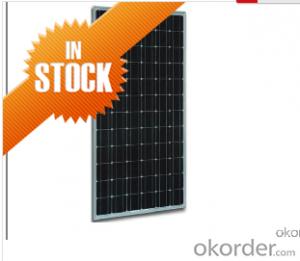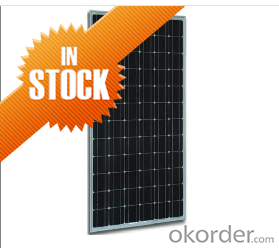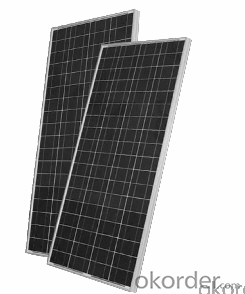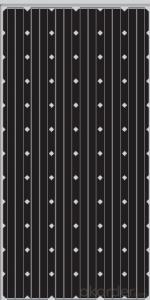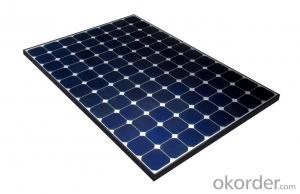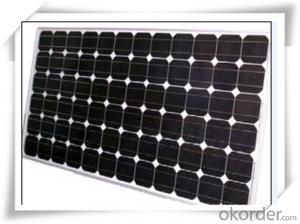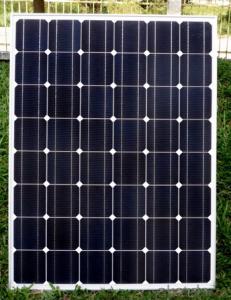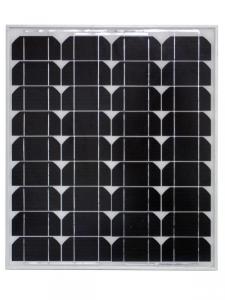Grape Solar Mono Solar Panels CNBM 280W-300W with Competitive Price
- Loading Port:
- Shanghai
- Payment Terms:
- TT OR LC
- Min Order Qty:
- 10 pc
- Supply Capability:
- 600000000 pc/month
OKorder Service Pledge
OKorder Financial Service
You Might Also Like
Product Description:
Introduction of Mono Solar Panels CNBM 280W-300W
CNBM Solar photovoltaic (PV) Panel is designed for large electrical power requirements. It is the optimal choice for both on-grid and off-grid power systems. CNBM Solar panel offers high performance of power per square foot of solar array. Monocrystalline silicon(c-Si): often made using the Czochralski process. Single-crystal wafer cells tend to be expensive, and because they are cut from cylindrical ingots, do not completely cover a square solar cell module without a substantial waste of refined silicon. Hence most c-Si panels have uncovered gaps at the four corners of the cells.
Characteristics of Mono Solar Panels CNBM 280W-300W
I.Solar Cell : High efficiency crystalline solar cell. Even if under the weak light, the solar module can produce maximum power output.
II.Tempered glass (toughened glass): Anti-reflecting coating and high transmission rate glass increase the power output and mechanical strength of solar module.
III.EVA and TPT: Using high quality EVA and TPT to prevent destroying and water.
IV.AI frame: Without screw, corner connection. 6 holes on the frame can be installed easily.
V.Junction box: Multi function junction box with water proof.
VI.Long lifetime: ≥25 years; Less power decrease.
VII.Good performance of preventing from atrocious weather such as wind and hails.
VIII.Resisting moisture and etching effectively, not effected by geology.
IX.The certificate issued by international authority: UL, TUV, IEC, VDE, CE.
Images:
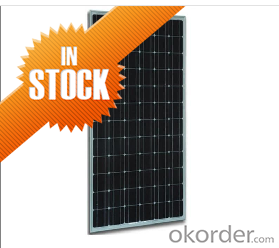
Standard Test Conditions of Mono Solar Panels CNBM 280W-300W
The opto-electrical specifications shown below are stabilized values being measured at Standard Test Conditions, Irradiance: 1000W/m2, Spectrum: AM1.5 at 25°C, The info below is subject to manufacturing tolerances. Where appropriate minutes of measurement are available and are used for the dimensioning of the installation.
FAQ: What's the advantages of CNBM?
CNBM Solar performance guarantees for 25 years
• 12 years guarantee for workmanship
• Timeliness of delivery
• Quality Products certified (TÜV, UL, CE, VDE, ISO)
CNBM International Corporation's products including Monocrystalline Solar Panel, Polycrystalline Solar Panel have received and enjoyed famous reputation in many countries and regions in the world .As a solar panel manufacturer in China, we strive to provide our customers with excellent service, superior products and unmatched value.
- Q: Are there any restrictions or regulations regarding solar panel installations?
- Yes, there are restrictions and regulations regarding solar panel installations. These can vary depending on the location and jurisdiction. Some common restrictions include obtaining permits, adhering to building codes and zoning regulations, and complying with utility interconnection requirements. It is important to check with local authorities and consult with professionals to ensure compliance with all applicable restrictions and regulations before installing solar panels.
- Q: Can solar panels be used in areas with high levels of sand or dust deposition?
- Yes, solar panels can be used in areas with high levels of sand or dust deposition. However, the accumulation of sand or dust on the surface of solar panels can reduce their efficiency. Regular cleaning and maintenance of the panels are necessary to ensure optimal performance in such environments. Additionally, the tilt and positioning of the panels can be adjusted to minimize the impact of sand or dust deposition.
- Q: Can solar panels be installed on a metal roof?
- Yes, solar panels can be installed on a metal roof. In fact, metal roofs are often considered ideal for solar panel installations due to their durability, longevity, and compatibility with the mounting systems. Metal roofs provide a stable and secure foundation for solar panels, ensuring optimal performance and longevity of the system.
- Q: How can I start working as a solar panel installer/technician without years of education?
- The best suggestion I can give is to call solar installation companies in your area, and ask for their recommendation as to what to do. They may recommend a technical college with an appropriate program. With unemployment rising, new jobs in solar will likely be scarce for a while. You might also inquire at roofing companies. If you apply at a solar company, and can demonstrate that you already have roofing experience, that will be a plus.
- Q: How much space is required for solar panel installation?
- The amount of space required for solar panel installation varies depending on factors such as the size and type of panels used, as well as the energy needs of the property. On average, a residential solar panel system typically requires about 100-400 square feet of roof space per kilowatt of installed solar capacity. Additionally, ground-mounted systems may require larger areas, typically ranging from a few hundred to several thousand square feet depending on the system size. However, it is important to consult with a professional solar installer to determine the specific space requirements for your individual project.
- Q: Are there any safety concerns with solar panels?
- Yes, there are some safety concerns with solar panels, although they are generally considered safe. The main concerns include the risk of electrical shock or fire due to improper installation or maintenance, potential harm from falling panels or debris during severe weather events, and exposure to toxic materials used in panel manufacturing. However, these risks can be minimized through proper installation, regular maintenance, and adherence to safety guidelines and regulations.
- Q: I live in Los Angeles area, I see the ads that, they will install solar panel for $0. I would like to know what is the catch ?Thanks You.
- Read the terms and conditions! They will own the panel and receive payment for any power generated from it, as one example.
- Q: I know there's different brands of solar panels and they cost different amounts.But if anyone know the average price of one solar panel could you help me out?Also could you please list the size of the solar panel.
- That okorder /
- Q: i'm making a small solar panel powered fan but it cant run the cellphone vibration motor even i have place two x2 solar panel.
- A solar cell's purpose is to generate electricity through the release of electrons from a material that is bombarded by electromagnetic radiation or photons. Most crystalline solar cells are sensitive to visible radiation from 400 - 700 nanometers, which correspond to 3. - .8 electron volts, of the visible region as shown by ACEPT W3 Group (999) and also into the near infrared spectrum. As the wavelength of the electromagnetic radiation increases, the amount of electron volts decreases. This means that infrared radiation has less electron volts than the visible spectrum of light (because it has a larger wavelength than visible light) and ultraviolet and gamma radiation has more electron volts than both the visible spectrum of light and infrared radiation (because they have a smaller wavelength than both infrared and visible light). Abramowitz, M., Davidson, M., Neaves, S. (2003) wrote that all forms of electromagnetic radiation originate from the atom which contain orbiting electrons around its nucleus. When those electrons absorb more external energy than they can contain in order to be stable, the extra energy is released in the form of an electromagnetic wave. That electromagnetic wave contains a magnetic field and an electric field, one offset by ninety degrees to the other along the propagation plane.
- Q: How long does it take to install solar panels?
- The installation time of solar panels can vary depending on various factors such as the size of the system, complexity of the installation, and the availability of resources. On average, a residential solar panel installation can take anywhere between one to three days. However, larger or more intricate installations may require a longer timeframe. It is best to consult with a professional solar installer to get a more accurate estimate based on your specific requirements.
Send your message to us
Grape Solar Mono Solar Panels CNBM 280W-300W with Competitive Price
- Loading Port:
- Shanghai
- Payment Terms:
- TT OR LC
- Min Order Qty:
- 10 pc
- Supply Capability:
- 600000000 pc/month
OKorder Service Pledge
OKorder Financial Service
Similar products
Hot products
Hot Searches
